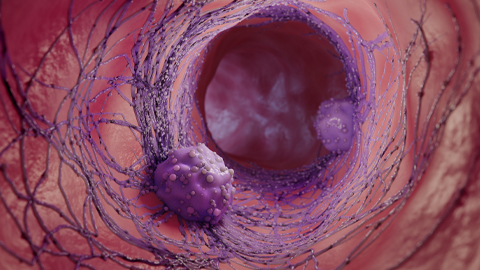From the journals: JBC
Linking modified cysteines to cell migration. Recognizing protein tags for degradation. Disrupting C. difficile toxin production. Read about papers on these topics recently published in the Journal of Biological Chemistry.
Linking modified cysteines to cell migration
Redox signaling includes the posttranslational modification S-glutathionylation, which results in an oxidized cysteine residue with glutathione attached via a disulfide bond. In cells, over 2,000 cysteine residues receive this modification, but scientists cannot easily assess which S-glutathionylation events connect to a given biological process. For example, researchers want to identify redox signaling proteins that drive cell migration, a process already known to involve S-glutathionylated proteins that regulate embryogenesis and maintain healthy tissues but can also lead to cancer metastasis under pathological conditions.

Dhanushika Kukulage from Drexel University and a team of researchers in the U.S. published a method in the Journal of Biological Chemistry to identify cell migration–related proteins with S-glutathionylated cysteines. Their platform uses proteomics, bioinformatics and biological screening. First, they used bioorthogonal chemistry and mass spectrometry to find proteins with the S-glutathionylation modification and compared this list with previously identified cell migration proteins. Next, they selected nine proteins based on activity classification for analysis in an oxidative stress–induced breast cancer cell migration assay. Expression of three of those proteins, the serine/threonine phosphatase PP2Cα, cytoskeletal reorganization protein ARHGEF7 and integrin signaling protein NISCH, increased oxidative stress and thus enhanced migration. The authors showed that this enhanced ability returned to baseline when they mutated the glutathionylated cysteine to serine, indicating a glutathionylation-dependent effect on migration.
PP2Cα expression showed a larger surge in cell migration, so the researchers chose this protein for further study. They determined that glutathionylation disrupts PP2Cα interactions with the kinases JNK, ERK1/2 and MEK4, which increases their phosphorylation levels and may enhance cell migration–related signaling.
Future studies will clarify how S-glutathionylation of ARHGEF7 and NISCH increases migration under oxidative stress. Finally, the authors emphasized the versatility of their platform; with different biological screens, researchers can investigate additional cellular processes and identify the associated S-glutathionylated proteins active in redox signaling.
Recognizing protein tags for degradation
The E3 ubiquitin ligase MARCHF6 is part of the N-degron protein degradation pathway that maintains protein quality control. MARCHF6 recognizes proteins with an N-terminal acetylation tag called Ac/N degrons and ubiquitinates them to drive proteolysis. Previously, scientists determined that MARCHF6 suppresses the iron-dependent cell death pathway, or ferroptosis, which is associated with numerous diseases, including cancer and neurodegeneration. Due to MARCHF6’s complex structure of transmembrane helices and cytoplasmic domains, scientists do not know the structural details of MARCHF6’s function.
Jihye Yang from Pohang University of Science and Technology and a group of researchers in South Korea examined the cytosolic domains of MARCHF6 and published their findings in the Journal of Biological Chemistry. The authors identified the region of MARCHF6 that recognizes acetylated N-terminal protein substrates and termed it the Ac/N domain because it distinguishes between acetylated and nonacetylated targets. The researchers also determined that MARCHF6-mediated degradation of the G-protein regulator RGS2 and the lipid droplet protein PLIN2 makes cells more susceptible to ferroptosis. They mutated the MARCHF6 Ac/N domain to determine that increased susceptibility to ferroptosis depends on MARCHF6’s ability to recognize acetylated RGS2 and PLIN2.
Future work will focus on dissecting MARCHF6’s substrate-dependent role in ferroptosis regulation. These findings could drive therapeutic developments for ferroptosis-related diseases, including cancer and cardiovascular diseases.
Disrupting C. difficile toxin production
Clostridioides difficile infects the colon and causes hundreds of thousands of infections annually in the U.S. Scientists want to find treatment options that target C. difficile’s unique pathophysiology, such as the biosynthesis of the toxins TcdA and TcdB, to avoid killing beneficial bacteria that help block pathogen colonization. Ravi Marreddy from Texas A&M University and a team of researchers in the U.S. recently published their work in the Journal of Biological Chemistry on the discovery of plant-derived compounds that inhibit toxin production but do not abolish bacterial growth. They investigated plant-derived compounds and selected the compound enoxolone, a licorice metabolite, for further study due to its potency in stopping C. difficile producing toxins.
The researchers used affinity-based proteomics and gene silencing to show that enoxolone halts toxin production by inhibiting adenine deaminase, which drives purine metabolism, and the adenosine triphosphate, or ATP, synthase, which is involved in energy production. The authors used surface plasmon resonance and isothermal titration calorimetry to show that enoxolone binds directly to the enzyme adenine deaminase. In addition, the authors used high-performance liquid chromatography to determine that enoxolone moderately reduced cellular ATP levels.
Future research will investigate how adenine deaminase and ATP synthase connect to toxin production and whether other enzymes in purine metabolism could become drug targets. However, in mice with C. difficile infection, treatment with enoxolone causes multiple side effects, so researchers will need to discover compounds related to enoxolone that mitigate these side effects to come up with possible treatments for C. difficile infections.
Enjoy reading ASBMB Today?
Become a member to receive the print edition four times a year and the digital edition monthly.
Learn moreGet the latest from ASBMB Today
Enter your email address, and we’ll send you a weekly email with recent articles, interviews and more.
Latest in Science
Science highlights or most popular articles

The science of staying strong
Muscles power every movement, but they also tell the story of aging itself. Scientists are uncovering how strength fades, why some species resist it and what lifestyle and molecular clues could help preserve muscle health for life.

Bacteriophage protein could make queso fresco safer
Researchers characterized the structure and function of PlyP100, a bacteriophage protein that shows promise as a food-safe antimicrobial for preventing Listeria monocytogenes growth in fresh cheeses.

Building the blueprint to block HIV
Wesley Sundquist will present his work on the HIV capsid and revolutionary drug, Lenacapavir, at the ASBMB Annual Meeting, March 7–10, in Maryland.

Gut microbes hijack cancer pathway in high-fat diets
Researchers at the Feinstein Institutes for Medical Research found that a high-fat diet increases ammonia-producing bacteria in the gut microbiome of mice, which in turn disrupts TGF-β signaling and promotes colorectal cancer.

Mapping fentanyl’s cellular footprint
Using a new imaging method, researchers at State University of New York at Buffalo traced fentanyl’s effects inside brain immune cells, revealing how the drug alters lipid droplets, pointing to new paths for addiction diagnostics.

Designing life’s building blocks with AI
Tanja Kortemme, a professor at the University of California, San Francisco, will discuss her research using computational biology to engineer proteins at the 2026 ASBMB Annual Meeting.

